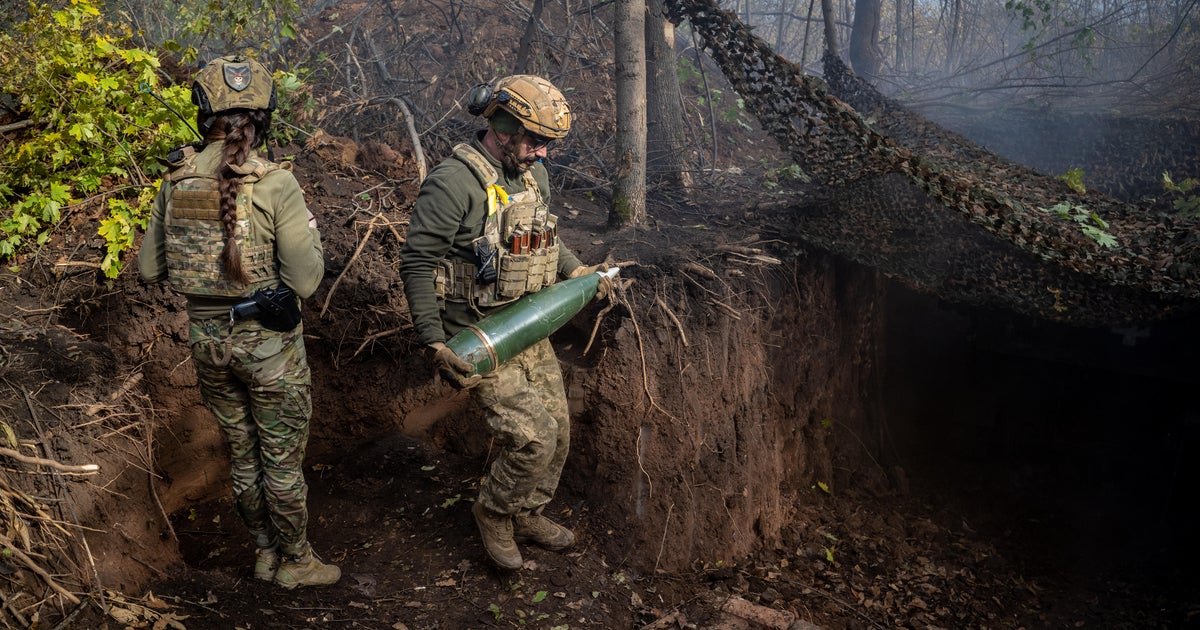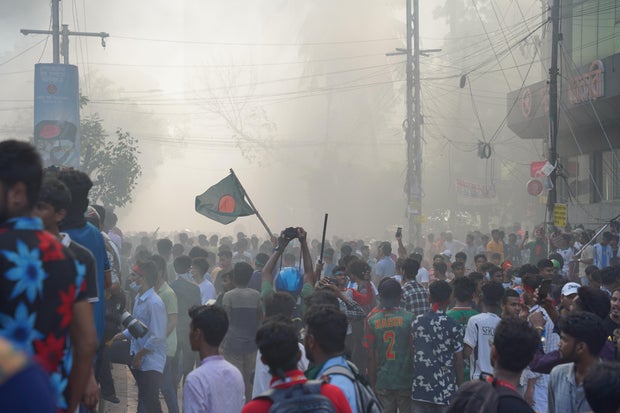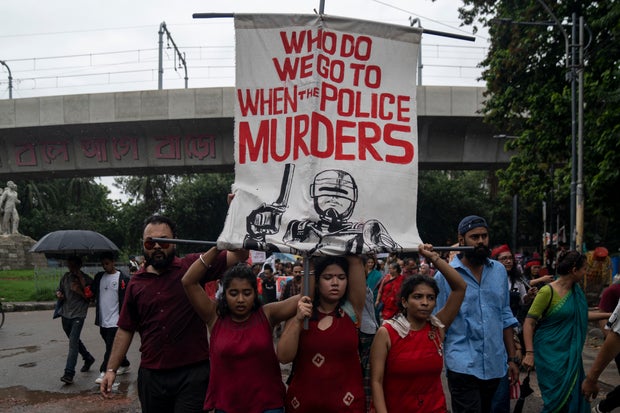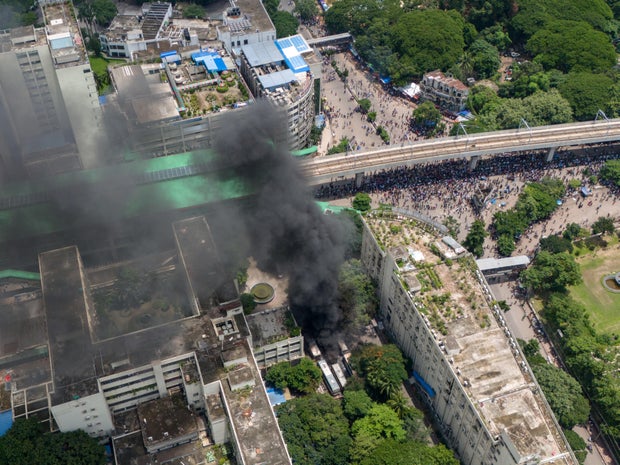CBS News
Nearly 100 killed, hundreds more injured in Bangladesh after renewed anti-government protests

Nearly 100 people were killed and hundreds more injured Sunday as renewed anti-government protests swept across Bangladesh, with protesters calling for the prime minister to resign and the prime minister accusing them of “sabotage” and cutting off mobile internet in a bid to quell the unrest.
The country’s leading Bengali-language daily newspaper, Prothom Alo, said at least 95 people, including at least 14 police officers, died in the violence. The Channel 24 news outlet reported at least 85 deaths.
The military announced that a new curfew was in effect Sunday evening for an indefinite period, including in the capital, Dhaka, and other divisional and district headquarters. The government had earlier imposed a curfew with some exceptions in Dhaka and elsewhere.
Parvez Ahmad Rony / Drik / Getty Images
Demonstrators are demanding Prime Minister Sheikh Hasina’s resignation following protests last month that began with students calling for an end to a quota system for government jobs. Those demonstrations escalated into violence that left more than 200 dead.
As the renewed violence raged, Hasina said the protesters who engaged in “sabotage” and destruction were no longer students but criminals, and she said the people should deal with them with iron hands.
The ruling Awami League party said the demand for Hasina’s resignation showed that the protests have been taken over by the main opposition Bangladesh Nationalist Party and the now-banned Jamaat-e-Islami party.
Also Sunday, the government announced a holiday from Monday to Wednesday. Courts were to be closed indefinitely. Mobile internet service was cut off, and Facebook and messaging apps, including WhatsApp, were inaccessible.
Junior Minister for Information and Broadcasting Mohammad Ali Arafat said the services were severed to help prevent violence.
At least 11,000 people have been arrested in recent weeks. The unrest has also resulted in the closure of schools and universities across the country, and authorities at one point imposed a shoot-on-sight curfew.
Protesters called for a “non-cooperation” effort, urging people not to pay taxes or utility bills and not to show up for work on Sunday, a working day in Bangladesh. Offices, banks and factories opened, but commuters in Dhaka and other cities faced challenges getting to their jobs.
Suman Kanti Paul / Drik / Getty Images
The demonstrators attacked Bangabandhu Sheikh Mujib Medical University, a major public hospital in Dhaka’s Shahbagh area, torching several vehicles.
Video footage showed protesters vandalizing a prison van in the chief metropolitan magistrate’s court in Dhaka. Other videos showed police opening fire on the crowds with bullets, rubber bullets and tear gas. The protesters set fire to vehicles and the ruling party’s offices. Some carried sharp weapons and sticks, according to TV footage.
In Dhaka’s Uttara neighborhood, police fired tear gas to disperse hundreds of people who blocked a major highway. Protesters attacked homes and vandalized a community welfare office in the area, where hundreds of ruling party activists took up positions. Some crude bombs were detonated, and gunshots were heard, witnesses said. At east 20 people were hit by bullets in the area.
At least 18 people were killed in the northwestern district of Sirajganj. That figure included 13 police officers who died after a police station was attacked by protesters, according to police headquarters in Dhaka. Another officer was killed in the eastern district of Cumilla, police said.
Five people died in the Feni district in southeast Bangladesh as Hasina’s supporters clashed with protesters.
Asif Iqbal, a resident medical officer at a state-run hospital in Feni, told reporters that they had five bodies at the hospital, all of them hit by bullets. It was not clear if they were protesters or ruling party activists.
In Munshiganj district near Dhaka, four people were declared dead after being rushed to a hospital, according to hospital official Abu Hena.
The Jamuna television news channel reported that violent clashes took place across more than a dozen districts, including Chattogram, Bogura, Magura, Rangpur, Kishoreganj and Sirajganj, where protesters backed by the main opposition party clashed with police and the activists of the ruling Awami League party and its associated bodies.
The protests began last month as students demanded an end to a quota system that reserved 30% of government jobs for the families of veterans who fought in Bangladesh’s war of independence against Pakistan in 1971.
Habibul Haque / Drik / Getty Images
As the violence crested, the country’s Supreme Court ruled that the veterans’ quota must be cut to 5%, with 93% of jobs to be allocated on merit. The remaining 2% will be set aside for members of ethnic minorities and transgender and disabled people. The government accepted the decision, but protesters have continued demanding accountability for the violence they blame on the government’s use of force.
The system also sets aside jobs for members of ethnic minorities and for disabled and transgender people, whose quotas were cut from a collective 26% to 2% in the ruling.
Hasina’s administration has blamed the opposition parties and their student wings for instigating the violence in which several state-owned establishments were also torched or vandalized.
Mirza Fakhrul Islam Alamgir, secretary-general of the main opposition party, repeated a call for the government to step down to stop the chaos.
Hasina offered to talk with student leaders on Saturday, but a coordinator refused and announced a one-point demand for her resignation.
Hasina repeated her pledges to investigate the deaths and punish those responsible for the violence. She said she was ready to sit down whenever the protesters want.
The protests have become a major challenge for Hasina, who has ruled the country for over 15 years. She returned to power for a fourth consecutive term in January in an election that was boycotted by her main opponents.
CBS News
Ukraine’s population has shrunk by 10 million since Russia first invaded, according to U.N. estimate

Geneva — Ukraine’s population has declined by around eight million since Russia invaded in February 2022, sparking an exodus and sending birth rates plunging, the United Nations said Tuesday. The U.N. Population Fund said there had not been a census, but that there clearly had been a dramatic population decline in war-torn Ukraine.
“Overall, Ukraine’s population has declined by an estimated 10 million since 2014 and by an estimated eight million since the beginning of the full-scale invasion in 2022,” UNFPA’s regional director for Eastern Europe and Central Asia Florence Bauer said in comments sent to journalists.
Ukraine’s population stood at around 45 million in 2014, when Russia first invaded, occupying and annexing Crimea, the agency said, citing data from the national statistics office.
By February 2022, when Russia launched its full-scale invasion of Ukraine, the population had dwindled to 43 million, and it has plummeted further to just 35 million today, it said, citing a combination of government and UNFPA data.
Speaking to journalists in Geneva, Bauer said the dramatic decline was due to “a combination of factors”.
Already before the war, Ukraine had one of the lowest birth rates in Europe, and like many countries in Eastern Europe, it had seen many young people leave in search of more opportunities abroad, she said.
But in the two and a half years since the full-scale invasion, some 6.7 million people have fled the country as refugees while the birth rate has fallen to just around one child per woman, she said.
Fermin Torrano/Anadolu/Getty
“That’s one of the lowest in the world,” she said, stressing that this was well below the theoretical replacement rate of 2.1 children that each woman on average must have to maintain the population size.
At the same time, Bauer said, there are the “several tens of thousands of casualties (from the war), which of course add to the equation.”
Neither Ukraine nor Russia have released casualty figures since Russia launched its full-scale invasion in 2022, but U.S. officials estimated in August 2023 that at least 70,000 Ukrainian service members had been killed. Since then Russia has made incremental gains along the vast front line stretching right across the east of the country.
CBS News
Have $15,000 in credit card debt? Here’s what a debt forgiveness plan could cover.

Getty Images
With credit card interest rates sitting at about 23% on average, many Americans are finding it harder than ever to keep up with monthly payments. After all, the average cardholder’s credit card debt is roughly $8,000 currently, and at today’s average rates, the interest charges can rack up quickly. And when you add in the other economic hurdles that are looming, like elevated consumer goods prices due to the lingering effects of high inflation, things can become even more challenging.
The combination of record-high credit card rates and high prices on essentials has created a perfect storm for credit card debt accumulation. As expenses like housing and groceries consume larger portions of monthly budgets, more people have turned to credit cards as a financial lifeline, only to find themselves trapped in an escalating cycle of debt. And for those with higher balances, the strain caused by compounding interest can become overwhelming, trapping them in a cycle of debt with no clear way out.
The good news is, though that credit card debt forgiveness could offer a way to reduce your debt. These programs allow you to negotiate with your creditors to settle for a lower amount than what you owe, providing a potential lifeline. But if you have a $15,000 credit card debt, how much will credit card debt forgiveness cover?
Learn about your debt relief options here.
How much of a $15,000 credit card debt will a forgiveness plan cover?
Debt forgiveness programs aim to reduce, not eliminate, your credit card debt, so in most cases, you won’t walk away with a zero balance. By taking this route, though, you could potentially settle for much less than you owe.
Credit card debt forgiveness typically allows borrowers to reduce their outstanding debt by 30% to 50% if the negotiations are successful. So, in the case of a $15,000 balance, this means you might end up paying back anywhere from $7,500 to $10,500, depending on the agreement you come to with your creditors.
The amount of your credit card debt that’s forgiven, though, depends largely on your financial situation and ability to negotiate with creditors. One issue is that to be considered for a forgiveness plan, most debt relief companies require you to have a minimum debt threshold, often around $7,500, to enroll in the program.
However, being eligible doesn’t guarantee that the negotiations will be successful. Creditors aren’t required to negotiate with you at all — and showcasing that you’re facing financial hardship is an important part of the equation.
That’s because creditors are more likely to settle your debts for less than what you owe, so you typically need to demonstrate genuine financial hardship, such as job loss, medical issues or other significant financial setbacks, as part of the process. If you’ve consistently made your payments on time, you might not qualify, as creditors tend to prioritize borrowers who have missed payments, signaling more severe financial distress.
While missing payments could improve your chances of qualifying, this strategy comes with serious consequences for your credit score and financial standing. But despite these drawbacks, the potential to drastically reduce your overall debt load can make forgiveness plans an attractive option for those struggling to keep up with their payments.
Find out how to get rid of your credit card debt now.
What are my other debt relief options?
Debt forgiveness is just one way to tackle your high credit card balances. If you’re not a candidate for debt forgiveness or want to explore alternatives, there are several other options to consider, including:
- Debt consolidation: When you pursue debt consolidation, the goal is to combine multiple credit card debts into one loan with a lower interest rate, making it easier to manage payments and reduce overall costs. By consolidating, you can streamline your debt repayment and potentially shorten the time it takes to become debt-free.
- Debt management: Offered through credit counseling agencies, debt management programs help create structured repayment plans with lower interest rates and waived fees. These plans can make monthly payments more affordable and help you pay off debt faster without the need for negotiations with creditors.
- Balance transfers: Some credit cards offer 0% interest for a set introductory period, typically 12 to 21 months. Transferring your high-interest credit card debt to a card with a 0% APR allows you to save on interest and focus on paying down the principal balance.
Each of these options has its own set of benefits and drawbacks, so it’s important to carefully evaluate which one is best suited to your financial situation. Seeking professional advice from a debt expert can also help clarify the best path forward.
The bottom line
For those facing $15,000 or more in credit card debt, debt forgiveness could provide much-needed relief, but it’s unlikely to wipe out the entire balance. A successful negotiation with your creditors could reduce what you owe by a substantial amount, though, giving you room to breathe. However, it’s essential to consider all your debt relief options, including debt consolidation loans, debt management programs, and balance transfers, to find the solution that best fits your needs. The right strategy can make a world of difference in reducing your debt and restoring your financial stability.
CBS News
Hopes not high for cease-fire talks with Blinken again in Israel to try to revive negotiations

Watch CBS News
Be the first to know
Get browser notifications for breaking news, live events, and exclusive reporting.












